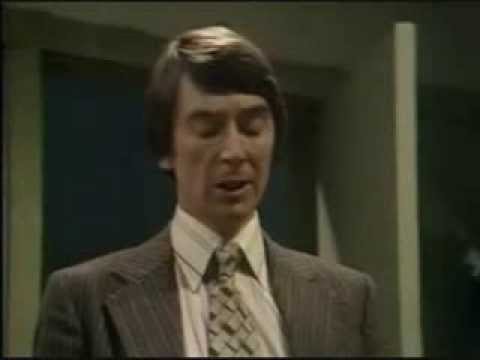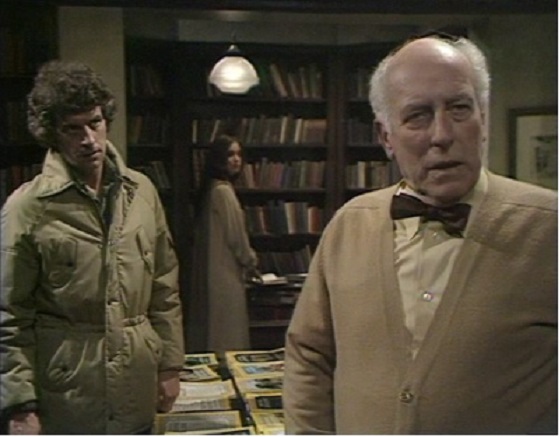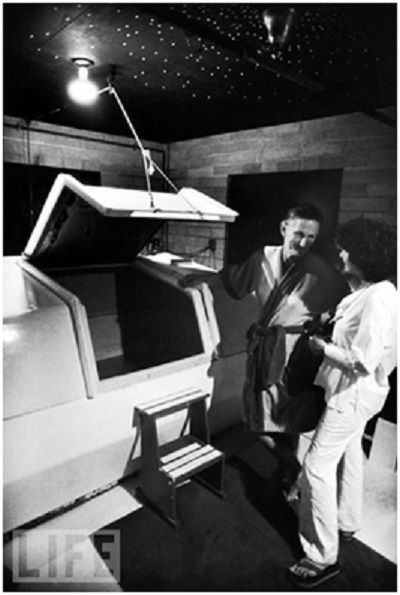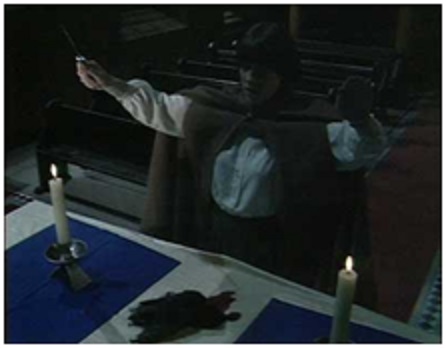The Paranormal on British TV: The BBC’s The Ωmega Factor

Starring James Hazeldine and Louise Jameson
(1979. 10 episodes, 3 disks, 510 minutes)
Saturday night at the 2016 Windy City Pulp and Paper Show back in April, I had dinner with John O’Neill and several others, including Arin Komins and her husband Rich Warren. During our discussions about Blake’s Seven and The Sandbaggers, Arin mentioned another BBC program, The Ωmega Factor. Her description sounded fascinating, so I bought it on Sunday from a dealer.
The Ωmega Factor is a British series about the limitless potential of the human mind and this theme is explored through various paranormal abilities. The show stars James Hazeldine (1947-2002) as journalist and psychic investigator Tom Crane; Louise Jameson, as psychic investigator Dr. Anne Reynolds; and John Carlisle as psychiatrist Roy Martindale. Crane and Reynolds report to Martindale who directly supervises Department 7, a secret British government group that explores psychic phenomenon mostly for use by the military.
Mind control, poltergeists, possession, witches, experimental devices, haunted houses and out-of-body experiences are a few of the paranormal subjects discussed in the ten episodes that were produced. Here’s a look at each one.

John Carlisle
1. The Undiscovered Country
Tom Crane’s investigations into the paranormal bring him in contact with the powerful and dangerous psychic Edward Drexel. Tom asks Drexel to help locate a missing girl as proof of his powers. Drexel tells Crane that he (Crane) has substantial psychic powers and could locate her himself. When Drexel refuses to demonstrate his clairvoyance gifts, Crane challenges him and is warned his continued investigations into the paranormal will bring tragic consequences.

Tom Crane, Drexel (Cyril Luckham) and Drexel’s servant, Morag (Natasha Gerson)
Using the images in his head, Crane finds the missing girl who has apparently committed suicide. But, tragedy strikes days later when Crane and his wife, Julie, are in a car accident involving illusions. Crane swerves to avoid hitting a woman standing in the road. Julie is killed when the car hits a tree.
When Department 7 recruits him, Crane explores his own psychic abilities and continues his hunt for Drexel. During Crane’s search, he comes in contact with almost every branch of psychic and New Age phenomena and slowly uncovers the existence of ΩMEGA, an organization determined to take over the world through mind control.
2. “Visitations”
Possession and mind control are featured in this episode. Mysterious events and a murder occur at a government safe house. Research shows a history of strange and sinister occupants, including a cult that was run by Drexel. Crane, his friend and confidante, Anne Reynolds and two technicians are sent to investigate. Their occult measuring devices include: infra-red film, electronic sensors and a cold/heat measuring instrument. Tom is attacked and nearly possessed by an evil spirit but is saved through the psychic intervention of his late wife and Morag, Drexel’s servant.
3. “Night Games”
Several volunteer soldiers are killed and others have their brains scrambled by an experimental sound device. The Army major who was operating the device at unsafe volumes was under the influence of Drexel. Sound, used in crowd control, can cause fits, epilepsy, madness, death and even hallucinations. Michael’s brother, one of the volunteers, is found wandering deranged in the area. He has memory gaps and is very agitated. Out of concern for his brother, Crane investigates. His efforts are blocked by uncooperative Army staff. In addition, he is warned by Martindale and his boss, Scott-Erskine to stop the investigation because it threatens their funding.
4. “After Image”
This episode delves into the use of sensory deprivation tanks. Until this point in the series, I relied on producer George Gallaccio’s statement that he “was keen to make the series as scientifically accurate as possible within the admittedly grey areas of parapsychology.” The technical advisor for the show was Archie Roy, a professor in Glasgow University’s Physics and Astronomy Department and a founder member of the Scottish Society for Psychical Research.
But, I was in familiar territory here. In the late 1970s I spent a summer working for John Lilly, who was the authority on dolphins, isolation tanks and research into altered states using hallucinogenics.
Mornings I typed Dr. Lilly’s dictation tapes for his upcoming book in return for tank time in the afternoons. I spent a total of 72.5 hours in isolation tanks at his home in the Malibu Mountains. Ironically, The Ωmega Factor was being shown on British TV just about the same time. In fact there are several references in this episode about people in California using isolation tanks for pleasure.

1967. Physician and psychoanalyst John Lilly and his wife Toni at
their home on Decker School Road in Malibu, California before
her death in 1986 and Lilly’s subsequent move to Hawaii
“After Image” begins with a discussion of sensory deprivation tanks: “Within ten minutes you are hallucinating” and “a half hour seems like a day and a half.” Through an observation window we watch as a young college volunteer is hypnotized and regressed to five years old, then two years, six months, one month and lastly to the moment of birth. At this point according to one of the observers, the mind is wiped clean and can be reprogrammed however desired.
Anne receives an invitation to do research at the leading sensory deprivation tank institute in Paris. She is given a knockout pill on the train and wakes in what she thinks is the institute. Like the college student, the “sensory deprivation tank” she uses is a room of unrelenting white containing only a large bed. The explanation for this environment is its featurelessness. The participant wears goggles and earphones (also white) that block out light and sound. I’m not sure any such isolation tank exists but perhaps it made filming easier.
My experience with tanks was much different from Anne’s. My favorite was about 6.5 feet long, about 5 feet high and about 4 feet wide. The middle section of top lifted for entry and exit. Before my first experience, John Lilly opened the top and said “The only thing inside is whatever you bring in yourself.”

The Lillys had several tanks. This photo closely resembled the one
I used most frequently, although there were rounds ones available
also. The couple in the photo I believe are John and Toni Lilly
The inside of the section that opened was covered with foam rubber so it was easy to identify the doorway to the outer world. I stepped into the tank nude. The water inside was heavily salted and about three feet deep, allowing me to float freely. When I closed the door and laid down, only my face between the eyebrows to just below my lips was above water. There was no sound and it was pitch black. The water was blood temperature so there was no sense of touch or feeling. My longest session was 3.5 hours but my optimum time was 1.5 hours. The statement “within ten minutes you start hallucinating” is partially true. Initially I felt claustrophobic. Lying in the water, the top of the tank felt a few inches from my face although I knew it was at least four feet away. I decided since my mind could fool me into believing it was that close, the opposite was also true so I pushed it miles away and the claustrophobia went with it.
In contrast, Anne Reynolds, dressed in a white hospital gown, lies on a white bed with sound blocking earphones and a mask blocking all light. Although the “After Image” episode did address the issue of sight and sound, the white room would not nullify the sense of touch.
Anne falls asleep for 2.5 hours. When she awakens, they ask her how long she’s been in there. She says 10 hours. It wasn’t clear what she meant by that. Floating in a sensory deprivation tank is very relaxing and an hour inside is usually considered to equal three hours of meditation. After over two hours, she could have felt as if she had ten hours’ sleep. I didn’t experience any sense of time loss. I could usually tell within five or ten minutes how long I was in the tank. However, my sense of touch was altered. The blood temperature of the water gave no external feedback of the outside world. Moving a couple inches inside the tank felt like floating a great distance across the sky and it was exhilarating. However, when a strand of my very long hair wrapped itself around my lower leg, it felt as big as a snake. I was a little disconcerted until I remembered John Lilly’s advice. Again, these differences between Anne’s experience and mine were environmental. Anne was lying on a bed and she also had tasks to perform.
Her tank time was also complicated by the presence of the two researchers who were communicating with her through her earphones. Unknown to Anne, one of them was Drexel who was determined to brainwash her. He was close to accomplishing it before he was stopped by Crane.
Isolation tanks were popular subjects in other movies of that time including 1980’s Altered States with William Hurt. They also figured strongly in two or three Fringe episodes in 2008. The environment inside the tank in both these examples was more accurate but the personality changes of the characters were bizarre.
5. “Powers of Darkness”
This was one very dark episode. The show begins with three young adults use a homemade Ouija board. Their questions at first are pretty innocuous “Is anyone there?” The answer of course is yes and it spells out “E*F*F*I*E.” It also warns them to “beware” but is not more specific. This Ouija incident leads to an amateur hypnotism session, regression to a past life (shades of Bridey Murphy), possession by a witch, a Black Mass and a close encounter with a demon. An October 7, 2015 article on the website The Angriest discusses the episode:
In a trance Jenny re-lives a past life as Effie, a 16th century witch burned at the stake on the orders of King James. When she re-lives her execution, her boyfriend Ian – locked inside a hospital after a nervous breakdown – spontaneously combusts and burns to death, screaming and flailing. This is really dark stuff, and it gives the episode an edge that it largely retains even today, more than 36 years later. This doesn’t even include the bit where the devil turns up.
The Angriest also addresses the show’s cancellation.
In the 1970s there was a highly active and vocal lobby group in the United Kingdom known as the National Viewers and Listeners Association… The group was fronted by a woman named Mary Whitehouse. Whitehouse protested to BBC management that the episode clearly breached their own content guidelines, let alone public morals. For once Mrs Whitehouse was right. The BBC openly acknowledged that the episode, and a subsequent one [“Child’s Play”], breached their own guidelines for content in prime-time drama programmes. Producer George Gallaccio was formally reprimanded and, when the time came, The Omega Factor was quietly refused a second series.
The article adds not only did the series not get renewed, “it was never repeated on British television, was never released on VHS and only resurfaced via DVD in the past decade or so” [emphasis mine]. While the content of “Powers of Darkness” and other edgy episodes may have led to the early demise of the show, they also gave The Ωmega Factor an enduring cult status.

Scene from the Black Mass performed in “Powers of Darkness”
6. “Child’s Play”
This episode focuses on poltergeists (psycho kinesis) — a mischievous force that plays tricks and usually appears in children. When this happens to Colin, the son of Anne’s friend, Roy Martindale brings the boy to the Institute for study. When Colin becomes sleep deprived and loses weight because of the long hours, Anne and Tom protest. Martindale and his superiors ignore their concerns and are adamant that his value to their experiments takes priority. When the boy blows up a ship using his powers, their interest intensifies. But the kid has a mind of his own — literally!
7. “St Anthony’s Fire”
This episode opens with a very intense scene. A husband and wife who are friends of Tom’s die when he is stabbed to death by his wife who dances toward him laughing hysterically. She subsequently drowns herself. Tom and Anne travel to a remote Scottish Island to investigate their deaths. They discover the couple’s ecological research facility was just sold to a conglomerate. Soon, others on the island are acting violently also. All this is explained by St. Anthony’s Fire — a disease that results when certain alkaloids from rye and other cereals are ingested causing an extremely painful burning sensation in the limbs and sometimes mania and psychosis. In medieval times the St. Anthony’s Fire symptoms were considered witchcraft.
8. “Out of Body Out of Mind”
The focus here is astral traveling (astral projection.) Martindale is experimenting with how to control it using Michael, Tom’s brother. This concept is mixed in with a plot to kill the president of Africa at a secret government meeting using psychedelic drugs. The president is friendly to Great Britain and his would-be successor is not. Again, Martindale is more focused on the success of the experiment than Michael’s welfare. Tom stops the session knowing astral travel can be dangerous when it starts exploring other worlds and meeting the dead.
9. “Double Vision”
ΩMEGA attempts to discredit Crane by arranging sightings of his dead wife. Tom begins to believe she is still alive. All these sightings are discounted by his colleagues so he sets out to investigate their validity. The episode also focuses on using psychedelic drugs to expand the mind and change reality. Mention is made of Carlos Castaneda who wrote the very popular 1970s series about don Juan, a shaman in Mexico.
10. “Illusions”
Dr. Bruckner, an East German psychic defects to Britain in order to teach Crane how to control his psychic powers. Bruckner is kidnapped by ΩMEGA and his mind is destroyed in an attempt to force him to work with them. This is the last episode so many issues, such as the conspiracy to take over the world are resolved or at least sort of. There is room left for speculation and sequels which never happened.
My overall impression of The Ωmega Factor is many of the episodes were intense, suspenseful and well written. The Angriest blog states:
The direction is occasionally a bit static and theatrical, but then BBC drama from this period generally was. Put in its historical context it’s one of the best bits of telefantasy the BBC ever produced.
What I least enjoyed was the concept of a secret government agency, Department 7, being in charge of the paranormal investigations. Since the focus of the research was its value to the military, discussions about the paranormal were often superficial.
I had the same concerns about the secret society conspiracies storylines. I wanted more paranormal subjects and less about conspiracies. I thought The X-Files in the 1990s fell into this same trap and when they did, the focus changed. It was no longer about the strange and weird phenomenon found in the basement files. It was about evil people working for mysterious government agencies and The X-Files went from storytelling to soap opera in many later episodes.
On the other hand, there was a lot to enjoy in The Ωmega Factor. I thought the series covered the 1970’s fascination with psychic phenomena quite well. It was an era of mind expansion studies. For many seekers this involved meditation or sensory deprivation tanks. For others it was done through acid trips and the use of peyote. Some, like John Lilly, combined the two. It was a time when possibilities led to many “what if’s” — a subject area I find continually fascinating.
Thanks Arin for the tip!
Barbara Barrett’s last article for us was Valentine’s Day—Robert E. Howard Style.
You are very welcome!
What a lovely writeup, and I can see that the next time I see you that we’ll have more to discuss (and I have more recs!)
The series is at its best when it creates atmosphere; Visitations and Powers of Darkness are my all time favorite episodes, with Child’s Play just behind them.
Visitations and the house; Powers of Darkness in the church. Brilliant scenes, both of them.
Also of note: the series has been continued via audio adventures produced by Big Finish. Unfortunately, it’s after Hazeldine died, but they do have Louise Jameson in them. The stories are….not quite as good, but still worth listening to.
They also released the original novel (by Jack Gerson) in audio format, read by Louise. (Original novel is well worth reading!)
https://www.bigfinish.com/ranges/v/the-omega-factor
Now I have to go tweet and FB link to this post, since The Omega Factor doesn’t get nearly enough love!
Should also mention that your adventures with John Lily and the isolation tanks sound fascinating.
Dear Ms. Barrett,
You worked with Dr. Lilly? Wow. I worked with Dr. Lou Herman in Honolulu, and he had some fascinating stories about Dr. Lilly.
The Omega Factor was a wonderful British import that snuck onto PBS in the 1980s, along with other speculative series like An Englishman’s Castle (Kenneth More writing a soap opera in a German-occupied 1970s Britain). It was The Omega Factor that came to mind for me (along with The Night Stalker) when I first started watching The X-Files. I liked the conspiracy element, even if it tended to devolve into more paranoia/betrayal soap opera-esque scenes. Omega Factor also posed a delightful bit of cognitive dissonance for me when the local Dr. Who broadcasts caught up to episodes featuring Tom Baker’s feral female companion, Leela (Louise Jameson), and I kept seeing Dr. Anne Reynolds.
As for Ms. Whitehouse and her vocal outrage, well, no coincidence that the Monty Python gang in their “Election Night Special Report” skit (mostly remembered for the Silly Party candidate names) reported one result as “Mary Whitehouse has just taken Umbrage. Could be a bit of trouble there.”
Hi Eugene,
Thanks for the heads up on AN ENGLISHMAN’S CASTLE. It’s currently not available on DVD for Region 1 but I’ll keep an eye out for it. What a great parody of Mary Whitehouse! Thanks for sharing that…It’s priceless. I watched many of THE OMEGA FACTOR episodes several times and during each viewing I was amazed at the nuances that I had previously missed. It’s a fun series.
It’s my turn to say “Wow!” When did you work with Dr. Herman in Hawaii? My experience with John Lilly started when I read THE CENTER OF THE CYCLONE. I traveled to Berkeley to hear him lecture and talked with Toni Lilly. They were looking for someone to type up his dictated notes so the next time I was in Los Angeles area, I drove to their home. I was excited as I was heavily into mind expanding experiences without the use of drugs. Lots of John Lilly stories. I think I still might have journals from those days. It would be interesting to re-read those experiences.
Did Dr. Herman have sensory deprivation tanks available for use?
Thanks for the comments!
Barb
Barbara,
An Englishman’s Castle was only recently released on DVD in the UK (Oct. 2015), which news is what brought it back to my mind. That, and finally figuring out the haunting closing theme is Ennio Morricone’s “Chi mai”.
I had 3 opportunities to work with Dr. Herman at his Kewalo Basin Marine Mammal Lab from 1996 through 2000, thanks initially to Earthwatch. And both of Dr. Herman’s outdoor tanks were filled with dolphins, so no sensory deprivation but an amazing amount of interaction with the cetacean “staff”.